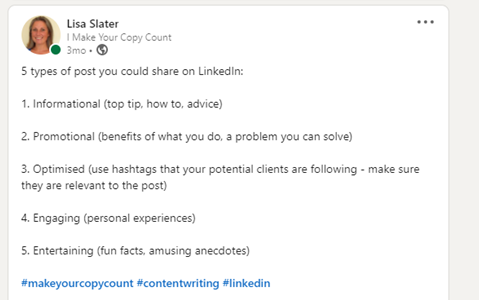Getting the best from your blogs
Blogs are fantastic for resharing and repurposing. They are one of the most versatile and cost-effective types of content you can create.
They can be easily shared anywhere and everywhere – on social media, via email, even in a text. All you need to do is copy and paste the URL (link address).
The other advantage of blog posts is they are easy to update, so you can make tweaks whenever you need to add new information or change any out of date statistics.
Sharing
Publishing your blog post is only the first step. Nobody is going to find it if you don’t tell them it’s there. So once your post is live, you need to share, share, share.
Depending on how your website is set up, some social media sites will automatically pull through the header image, title and an excerpt when you share the link. If not, you can do this manually.
I create a header image for each blog post that includes the title. I then make a smaller square version that can be used on different social media pages if they don’t pull through the image automatically.
When you share a link to a blog post, it can be a good idea to give it a bit of context rather than just sharing the link. Summarise the content – give readers a reason to click through and read your blog.
As well as social media, you can share your blog post in email newsletters, any private groups you run, and on your Google dashboard.
And don’t forget to include links to past blog posts in your new posts. You’ll always find a related articles sections at the bottom of my blog posts – it helps people find other relevant content.
Resharing
I always recommend publishing your original blog posts on your own website first. But once your blog post has been live on your site for a couple of weeks, you can reshare the same post as an article on Medium and/or LinkedIn.
Medium makes it really easy to share your article. All you need to do is copy the URL, go to your Medium profile, click on stories, import a story and then paste the link. You can then make any changes or tweaks to the wording, format or images before you click publish.






